Posted by
Sharad Agrawal
on
September 02, 2011

Bassi Wildlife Sanctuary is a wildlife sanctuary near Bassi in Chittorgarh district of Rajasthan, India.
5 kilometers from the Bassi Fort Palace.
1.5 hours of small journey from nearest Airport Maharana Pratap Air Port , Dabok , udaipur
It covers an area of 15,290 hectares and was established in 1988.
It has series of tableland, gentle slopes and vast stretches of large lakes, water channels of which penetrate into the forest.
Placed itself at the backdrop of lush green forests of Vindhyachal ranges, it is a noticeable wild life protection place, providing a natural habitat for varied species of wild life.
Orai dam and Bassi dam form part of this nice wildlife sanctuary. Antelopes, Leopards, mongoose and wild boar are some of animals inhabit the sanctuary.
Many migratory birds are spotted in the seasons.
No doubt, it’s a haven for wildlife enthusiasts.
Our one day experience to sanctuary was mind blogging ..as per photography level it was quite challenging that day because of heavy clouds..
01. Rock Eagle Owl or Bengal Eagle Owl (Bubo bengalensis)
02. Lesser Golden-backed Woodpecker (Dinopium benghalense )
03. Savanna Nightjar, Caprimulgus affinis...ID nor confirmed..
04. Indian Pitta, Pitta brachyura
05. Jungle cat (Felis chaus)
06. Blue Bull
07. White-eyed Buzzard (Butastur teesa)
08. Painted Spurfowl (Galloperdix lunulata)
09. Black Francolin, Francolinus francolinus
10. Black-headed Cuckoo-shrike (Coracina melanoptera)
11. Asian Paradise-flycatcher (Terpsiphone paradisi)
12. Oriental White-eye, Zosterops palpebrosus
13. Knob-billed Duck (Sarkidiornis melanotos)
14. Lesser Whistling Duck
15. Painted Stork (Mycteria leucocephala)
16. Asian Openbill Stork, Anastomus oscitans
17. Asian Brown Flycatcher, Muscicapa dauurica
18. Golden Oriole (Oriolus oriolus)
19. Rufous Treepie (Dendrocitta vagabunda)
20. Common Iora (Aegithina tiphia)
21. Red-vented Bulbul (Pycnonotus cafer)
22. Shikra (Accipiter badius)
23. Sparrowhawk (Accipiter nisus)
24. Chestnut-bellied Sandgrouse, Pterocles exustus
25. Brown Fish-owl (Bubo zeylonensis or Ketupa zeylonensis)
22. Oriental Honey Buzzard, Pernis ptilorhynchus
23. Crested Serpent Eagle (Spilornis cheela)
24. Plum-headed Parakeet (Psittacula cyanocephala)
25. Rose-ringed Parakeet (Psittacula krameri)
26. Indian Peafowl or Blue Peafowl (Pavo cristatus)
27. Rufous-tailed Lark (Ammomanes phoenicura)
28. Common Kingfisher, Alcedo atthis
29. White-throated Kingfisher (Halcyon smyrnensis)
30. Black Drongo (Dicrurus macrocercus)
31. Spotted Owlet (Athene brama)
& ETC ETC ETC...
Last not least KING OF SAARNA( LEOPARD) from Rishiraj Deval...
For snaps from sanctuary plz look at the link bellow
http://www.indianaturewatch.net/view_cat.php?tag=BASSI%20WILDLIFE%20SANCTUARY
For more details on BASSI WILDLIFE SANCTUARY plz call shri Rishiraj Deval ..his cell no. are +91 7891100000
Regards & regrets for mistakes
Sharad Agrawal
with many more to explore yet..
|
Posted by
ashish
on
August 27, 2011
i was go to bhandhavgarh it was so good...
|
Posted by
Murali
on
January 18, 2011

Birding in Rollapadu Wildlife Sanctuary, Andhra Pradesh:
Grassland ecosystems are one of the finest ecosystems in the world which support very good populations of birds especially
the grasslands specialist. Among such grasslands ecosystems in India, Rollapadu wildlife sanctuary is one of the finest grasslands present in India. This sanctuary was formed in the year 1988especially to protect the endangered bird The Great Indian Bustard
(Ardeotis nigriceps) and also Lesser Florican (Sypheotides
indicus) which nests in this region.Topography of the sanctuary is gentle
undulating plains with an elevation of 290m and vegetation is of Southern Tropical Thorn Forest type. Climate is mostly hot and dry for a period of more than 8 months with mean annual temperatures about28°C, maximum being 42°C and minimum being 18°C.Average
rainfall of the area is 450mm and usually it varies. It is open dry grassland with interspersed thorny bushes. The flora includes grasses like Arisitida
funiculata, Chrysopogon fulvus, Heteropogan contortus, Sehima nervosum, Dicanthium pseudoischaemun and small tree species like Morinda sp,
Pheonix sp. etc. Fauna includes blackbuck, jackal, wolf, Indian fox, bonnet
macaque, Indian bustard, Indian roller, sparrows, mynas and pipits, Russell's viper, Indian cobras etc.
The sanctuary is
bordered with the agricultural lands cultivated with dry-land crops like that of sun flower, tobacco and cotton. A small village named Rollapadu lies closely to the sanctuary. A mud-road passes through the sanctuary, which bisects the sanctuary; it is used
for transportation by villagers to reach the agricultural fields present on the other side of the sanctuary. A small man-made water body is maintained in the sanctuary to quest the thirst of wildlife. Alaganur reservoir is another man-made reservoir present
adjacent to the sanctuary to store the rain water. This is located three km towards east of Rollapadu village. Prosopis
sp. covers the dry area during dry season.
Nearly132 species of birds were recorded which included the resident and migrants (winter). The resident birds included a wide
range of them starting from small sized warblers to the huge sized Short-toed snake eagle. The tall trees interspersed provided nesting for the large sized raptors like that of Eagles and the old abandoned wells acted as nesting sites for the Eurasian eagle-owl.
The reservoir served as a roosting and nesting place for many aquatic birds including winter migrants such as the Bar headed geese, demoiselle cranes, harriers etc. Short-eared owls roosted in scrubby areas. It is also doubted that Greater Flamingo’s use this
area as passage route during their migration to southern parts of India.
For check list of Birds, Please mail me @ (murali7murali@gmail.com)
|
Posted by
Shirolkar BW
on
December 22, 2010
Magadi Lake is located in Gadag district of Karnataka state. It is a part of North Karnataka. Every year thousands of Bar headed geese come to this lake. This year some of my friends of North Karnataka Birder Watchers club has noticed two geeses which
are banded. They are successfully photographed and traced their origin to Mongolia.
Shirolkar
|
Posted by
Susan Sharma
on
February 21, 2008

12 Days Gujarat & Kutch Birding and Wildlife Tour - 18-11-2007 to 30-11-2007
Published by Arpit Deomurari (deomurari AT gmail.com),
Participants: Arpit Deomurari (Birding Expert), Mr. Ken Hatshorn (UK) and Mr. John Hollyer (UK).
Birds: 283 Spec
Kutch (Great Rann of Kutch):
 As we started from Kutch (Great Rann of Kutch), We had very good
sightings of 5 White napped tit, 2 pairs were on the same Bush and another single individual was 5-8 mt. away on the other bush. Another important sighting for Kutch was the Red-throated Pipit. We came across this very dark pipit on the coastal wetland near
Pingleshwar in Kutch region of Gujarat India on 19-11-2007. As we started from Kutch (Great Rann of Kutch), We had very good
sightings of 5 White napped tit, 2 pairs were on the same Bush and another single individual was 5-8 mt. away on the other bush. Another important sighting for Kutch was the Red-throated Pipit. We came across this very dark pipit on the coastal wetland near
Pingleshwar in Kutch region of Gujarat India on 19-11-2007.
After seeing this bird only two species come to our notice Pechora Pipit
Anthus gustavi and Red-throated Pipit Anthus cervinus. This is the first authentic record for the Gujarat state. After visiting Naliya Done and other area on the last day we had visited Chari Dhandh, A famous hot spot in Kutch for Raptors
and Grey Hypocolious, We sighted 12 Grey Hypocolious on the roosting time. And in the morning in the same area we had seen many raptor species including Steppe Eagle, Tawny Eagle, Imperial Eagle, Common Buzzard, Long legged buzzard, Marsh Harriers, Oriental
Hobby etc. This seasonal wetland has also large population of White Storks, and other wetland birds.
Also the Rock Eagle Owl, A recent split form Eurasian Eagle Owl was seen nesting on the “PAKHI BHEET” area of chari dhandh. This small hill in the Rann provides very good habitat for many species
which also include Red-tailed Wheatear, Brown Rock Chat etc. A pair of Jungle cat with its kitten was observed on both days at PAKHI BHEET area.
 
LRK ( Little Rann of Kutch):
The marshy habitat of Vanod Saran, nr. Dasada is also a very good hotspot for birders you can find good number of species over here including, white tailed lapwing, grey lag geese, bar headed geese,
cranes, crakes and rails, etc. The show master of this wetland were the rosy pastor they were atleast in 2000-5000 in strength comes here for roosting and their acrobatics are really great to see at sunset. The flocks of rosy pastor were also having small
no. of Common or European Starling.
The biggest attraction of Little Rann of Kutch was sightings of 45 Sociable Plover. 22-11-2007, at Little Rann of Kutch near Vanod Village. A flock of 45 birds were seen roosting at a site where
the author (Arpit Deomurari) has reported 27 same birds last(2006-2007) year also. This flock is considered as the largest flock of sociable lapwing found in India till date.
This Lapwing is also listed in the Red Data Book as a Critically Endangered Bird Species. They breed on open grassland in Russia and Kazakhstan. Three to five eggs are laid in a ground
nest. These birds migrate south through Kyrgyzstan, Tajikistan, Uzbekistan, Turkmenistan, Afghanistan, Armenia, Iran, Iraq, Saudi Arabia, Syria and Turkey, to key wintering sites in Israel, Syria, Eritrea, Sudan and north-west India. Birds winter occasionally
in Pakistan, Sri Lanka and Oman. It feeds in a similar way, picking insects and other small prey mainly from grassland or arable.
In 2004 BirdLife International categorized this bird as critically endangered, due to a rapid population decline for poorly understood reasons. The current population was estimated to be between 600 and 1,800
mature birds in 2006 (BirdLife International), but is currently being
 revised. The current IUCN revised. The current IUCN
classification is CR A3bc -
meaning that the population is expected to decline in the next decade or so by 80%, but based on theoretical considerations and the known habitat destruction rather than direct observation of the birds. Thus, the new discoveries might mean that as more
data becomes available, the species could be down listed to Endangered.

A Scientist working on the Sociable Lapwing Mr. Johannes Kamp has ringed 140 birds (mostly juv.) in Pavlodar region, NE Kazakhstan, this year (two colour rings on each leg, combination always starting with
a yellow ring). These birds are at the easternmost distribution border and thus supposed to go to India/Pakistan. Author (Arpit Deomurari) would like to ask any future observers to check these birds for color rings? The yellow ring is quite obvious to seeing
the field.
Another highlilght of the Little Rann of Kutch were 8
Macqueen’s Bustard (Chlamydotis macqueenii) in a 3 hours game drive and of course the largest lark of the world, Greater Hoopoe Lark(Alaemon alaudipes)
|
Posted by
Susan Sharma
on
January 30, 2008

Thattekhad “ The” Birding destination of South India-Dec 2007 ( Part II)
-Posted by Partha Pal in Delhibird yahoo group
Post lunch trip was with Girish (Mrs Sudha’s son) . I accompanied Girish and three Foreigners(Swede birder and Australian birding couple) to a different part of forest on lookout for Waynad laughing thrush. Though
it eluded us I got my first sighting of Malabar hornbill,
Malabar parakeet, Hill mynah ,Ruby throated Bulbul and Pompadour green pigeon. However the location for Waynad laughing thrush and the path was full of leeches . I was literally hooked on to shoes removing every time a leech crawled up, still I had eighteen
bites around the ankle to calf muscle. Other guys also met with the same fate except the lady. Reasons unknown ,probably fairer sex has advantage even in jungles.
Next two days were with Eldhose and I was looking forward to them. So much was written about him that I already had image of him bigger than life. Well he turned out to be very soft spoken, gentle ,down to earth person, whose only love is birds.
His preciseness of the location , sharp hearing , recognition of calls , all are amazing. There were so many incidents in two days you could only be stunned with Eldhose’s magic.
So we started of with Red spur fowl behind his house, white cheeked barbet ,Malabar grey hornbill at the Papaya tree next to his house.
For photographers he also creates a hide sort of situation where you can have really close photos of birds. Then it was the time of Mottled wood owl little distance from his home, followed by Blyth’s pipit. We took a brief break for breakfast. Post breakfast
session yielded Grey breasted prinia, Crested hawk eagle – As per Eldhose , a sub species of changeable hawk eagle which does not change, in sanctuary area – we saw Grey headed bulbul, Crimson backed sunbird, Brown breasted flycatcher, Crested serpent eagle,Grey
jungle fowl, White bellied treepie, fleeting glimpse of Crested goshawk a grizzly squirrel , flying lizards ,Asian Bird southwing and other butterflies.
Post lunch session produced a amazing collection of birds. We visited another part of the sanctuary. Blue throated flycatcher,Dark fronted Babbler, Chestnut tailed starling the south India sub species, Heart spotted woodpecker, Large cuckooshrike,Black headed
Cuckooshrike, Drongo cuckoo, Black napped monarch, Asian paradise flycatcher – all this at one location. Little further in the Jungle we saw a giant squirrel, plum headed parakeets, Fleeting glimpse of Besra and Chestnut winged uckoo.Malabar Parakeet, and
the Highlight of the trip – The beautiful Malabar trogon. I was so sucked up by the beauty, I forgot to shoot photos. The day does not end here. In absolute darkness Eldhose tracked down Indian Pitta and with the help of a small torch another species has etched
onto my memory.
Next day was my last day at Thattekhad and we had still lot of names in the list.. We started of with Black Baza – a beautiful princely bird. We had to wait nearly 45 minutes for the lone baza
sighting. While waiting for Black baza, White bellied and Rufous treepie, Large cuckoo shrike, Brown shrike, Black naped, Black hooded and Golden oriole , Black crested bulbul (Ruby throat -south Indian sub species)were seen. Next
in line was Blue bearded beater . Post breakfast sightings produced,Lesser yellow naped woodpecker – south Indian sub species, Streakthroated woodpecker and Yellow billed babbler . Then we took a long and beautiful drive to Edamalyar barrage where we
saw Dusky craig martin, White bellied treepie, Rufous babbler and on the way Common hawk cuckoo, Shikra and Paris peacock butterfly.
After having a hefty and late lunch at one of the Kerala dhaba we proceeded toward the sanctuary gate. Target was White bellied woodpecker, however due to less time I opted for Dollar bird. As usual Eldhose tracked down the Dollar bird and in process we saw
lots of Hill mynah,Malabar hornbill, Grey jungle fowl, Rufous treepie with a kill, hordes of caterpillar and a lone Oriental honey buzzard.
Quite a few names were still pending in the wish list, but I ran out of time, probably I can cover in my next trip.Eldhose has given a open offer - ten days in south India. He will show you 300 species.
Treated to a Icecream by Eldhose I said bye to Thattekhad . Thanking Eldhose and my stars that at least some part of the dream has been fulfilled. Those who are interested in hiring Eldhose services need to book minimum month or two in advance.
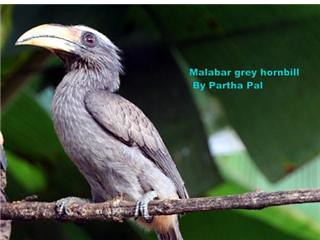

|
Posted by
Susan Sharma
on
January 22, 2008

Thattekhad “ The” Birding destination of South India-Dec 2007 ( Part I)
-Posted by Partha Pal in Delhibird yahoo group
Roughly 25 odd square kilometer of area but it boasts of 270 species and above. Two and half days of birding yielding 33 lifers and the greed to continue was still there,
unfortunately time didn’t allow.
Reached Thattekad around 11 a.m . Ashy wood swallow were the first ones to greet perched on the wire across the river. Happy with the good omen I continued and reached the sanctuary gate.
Sudeesh the young guide who is under tutelage of Eldhose was wating for me at the sanctuary gate. Since Eldhose was already booked for that day Sudeesh took me around for the first part of the day . My staying arrangements were done with a family who lives
within the sanctuary. Fresh home food and family atmosphere, very good host added to the good birding. The lady of the house Mrs.Sudha and other family members were extremely nice and caring. Incidentally her son is lawyer and also a
birding guide . His free time is taken up as birding guide.
My first foray into the forest - actually before that ,just next to the gate
a pair of brown hawk owl were roosting.(1st lifer of the trip) 12 hours of bus journey in normal circumstances I would have been sleeping like a log but here I was excited like a kid who has just been given a free hand. Late morning visit resulted in sighting
of five Srilanka frogmouth (really strange looking birds infact the way they sit still – just like statues.
Sudeesh advised that they won’t move unless you touch the bush they are sitting on.
We saw Giant wood spider with a huge web , fleeting yellow
browed bulbuls, Greater racket tailed drongo as common as black drongo in north, Bronzed drongo, Black napped monarch, Asian paradise Flycatcher, Forest wagtail and of course The Pit Viper (We managed to go as close as 12 inches . It lay lazily ,tummy was bloated
,must have good kill.
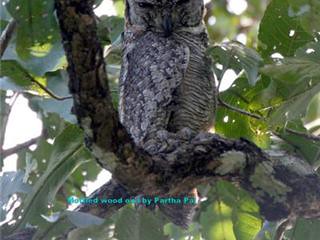

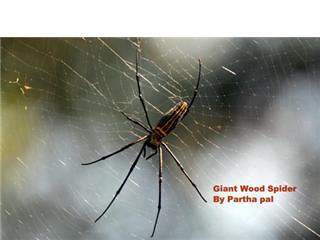

(Continued in next part)
|
Posted by
Karthik
on
May 20, 2007

Doddamakali Fishing Camp (12th May 07, 140kms from Bangalore)
My mind and soul both were craving for some kind of adventure and I was also sick and tired of slogging at work. Actually, I was looking for agn opportunity to unleash my Beast on the road and it came at the right time. This is about a trip that Netra (my
wife) & I cruised along the gorgeous locations of Karnataka (Halagur – Malavalli – Doddamakali) searching for Mahseer. It was just ’awesome’. That’s the only word comes to my mind when I think about it. This write-up is all about three entities - we two and
BISON (the Bullet).
Meandering through the woody landscape amidst the forests of Karnataka is the Cauvery the most majestic and sacred river of South India. The river offers both adventure and opportunity for nature lovers. Nestled along this mighty river is the Doddamakali
Fishing Camp, world-renowned as home to the great ‘Mahseer’ - the finest & the largest tropical sporting fish known to man. Tucked away from the milling crowds, yet close enough for you to reach, this camp offers a slice of nature that is entirely unique,
one in which you can totally feel free! JLR has exclusive rights to vast stretches of the Cauvery. Four different kinds of Mahseer (Large Headed) fish are found in these waters Silver, Gold, black and Pink. However, in light of decreasing sizes and numbers
of good specimens, ’Catch-and-Release’ has become a necessary practice. Other fish often found are carp, catfish and many small ones useful as bait.
Doddamakali Camp is situated 6km upstream from Bheemeshwari. This place is as remote, rugged and as primitive as any place could be. Hugging the River Cauvery, the Camp is absolutely protected and riparian—sylvan in solitude and great for bird sightings
& Mahseer fishing. Mammals that are spotted around the Camp include leopard, elephants, wild pigs, sambar, spotted deers, the highly endangered grizzled giant squirrel, Malabar giant squirrel and jackals. Reptiles that can be sighted are marsh crocodile, turtles
(Leith’s Soft Shelled Turtle, an endemic species is found in these waters), chameleon, python, cobra, russell’s viper and banded krait. However, the Mahseer fish is the main attraction of the waters of River Cauvery
Over 200 species of birds have been identified around the camp. Among the water-based birds, you can spot the grey-headed fishing eagle, spot billed duck, small pied kingfisher, black-bellied river tern, osprey, and many more. There are also a number of
rare land-based birds such as the honey buzzard, tawny eagle, pied crested cuckoo, etc. Our cruise was quiet smooth till Mandya through the four-lane highway. After that the roads were little bit rough & uneven. After doing some left, right turn and riding
on smooth road, Netra & I reached the old tarred road and then kacchi sadak.. the way to Doddamakali.. 8 km stretch which took us around 45 mins-1 hr. It was very interesting journey on that road both times. We were finally at camp at 11:40am, but via a slope
hugging zigzag path with no soul around.
After reaching there we were welcomed with a glass of lemon juice. It was like "amrut jal" or may be "tirthanm" after 3 hrs ride. I couldn’t resist jumping in to the river even after reading about crocs & whirlpools in the stream; swam for an hour and then
lunch around 1:30. After lunch we were at river side & I fixed my fishing rod to ankle the Mahseer; a legendary fighting fish which can grow to over 100lb in weight. These fish are famous for being able to strip a reel bare of 40lb line on the first run and
can easily swim upstream, against rapids, at over 20 knots. Netra was resting on hammock & fell asleep.
Putting her to sleep, I swiftly changed into my fishing gear and taking my trusty spinning tackle, called forth with determination. After I had worked out the kinks from my casting arm, I was rewarded by a Silver Mahseer, who seized my large spinner with
a vengeance as soon as it struck the water. In no time the reel was singing, my arm was straining against the pull from the Mahseer, who was whizzing downstream looking for refuge in the rapid and rocks. This gave me time to overcome the initial shock of hooking
a big one, and also a respite to my pounding heart. I now concentrated on landing this monster. The usual tricks of playing and tiring the fish were applied with great care and eventually I landed my first 1 pound Silver Mahaseer which is the smallest anyone
could catch, after about an hour of sheer grit and pleasure.
Around 4:00 we went for the coracle ride... Delirious with excitement, Netra & I jumped into the Coracle. Not fresh to such conduct, indulgent rowers stop me and hand over a lifejacket in glowing orange. I put it on, and gingerly get into a coracle that
shudders fleetingly under my weight. The coracle whirled, twirled, swirled, and finally drifted rhythmically. The oar touched the water with a plop & hit the rocks, Netra & I started disquieting the Gille (guide) for some local wildlife news as usual
We were there till the tea & planned to climb up the roads around 5:00pm, except for my BISON no vehicle can reach out there. On the way back we spotted couple of spotted deers, wild fowls, and mongoose. By the time we reached Halagur, it was past 6 pm.
Since we were on a day tour (no accomodation available for the night) we had to return to Bangalore. We had spent only about 8 hours at the camp but it was an extremely satisfying and relaxing trip. My mind was away from all the worries of every day life and
was raring to go back to work full blast.
Cheers Karthik
hrkart@gmail.com
|
Posted by
Raghavendra Rao
on
May 16, 2007

A Haven for Birds
-RagooRao
The River Kaveri, which takes it’s birth high up in the Western Ghats, flows down Karnataka state feeding the parched lands and turning them into bountiful yielders of precious
food and then meanders through the valleys of Tamil Nadu blessing them with her bountiful precious water for their land, finally merging with the Bay of Bengal.
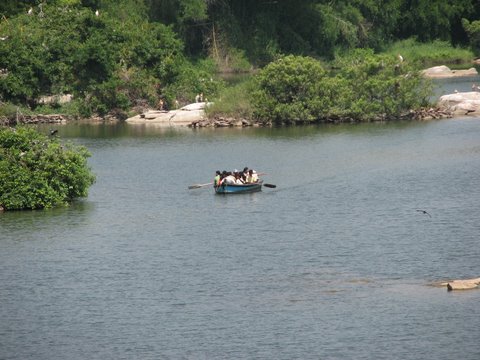
As the river flows through Karnataka over undulating terrain, plenty of small cataracts and some very impressive waterfalls are formed. This river is reverently called the
Life-Line of Karnataka. As the river meanders through the terrain plenty of small islands are formed all the way along it’s course. These islands are a host to plenty of Flora and Fauna all evolving with nature and thriving. One such spot in the river’s course,
close to Mysore-about 12 kilometers, is the Naturally formed group of islands filled with Pandanus plants, Pongamia trees, Mahua trees and a score of other plants playing host to many breeding birds. The banks of the river are filled with Bamboo and other
tall majestic trees. This is The Ranganathittu Bird Sanctuary, where regular nesting birds come to nest and raise their young.
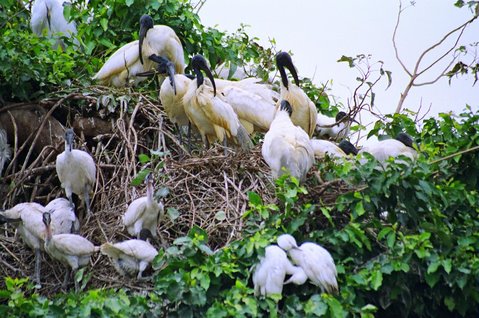
The river being filled with a lot of boulders also plays host to the Marsh Crocodiles and the waters are filled with fish. A pristine home for breeding birds. The
bamboo and other trees also provide a good habitat for most of the birds of Karnataka. The main season for the migratory breeding birds is from Aug to Sept. and
for the other breeding birds it is Dec to March. The islands are a very safe Haven for these nesting birds tucked away inside the deep waters of the river and safe from any land predators. The water being infested with Marsh crocodiles even human interference
and vandalism is kept at bay, thanks to the Marsh crocodiles. In one of the islands even the crocodiles build their nests and breed. One can always find the crocodiles basking on the rocks.
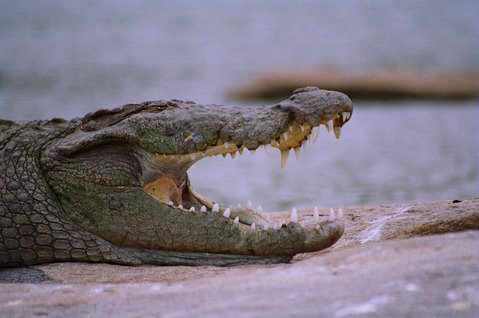
An ideal location for the birds. The river surroundings are all fertile paddy fields, which provide a good source of Crustaceans and other aquatic life as forage for
the parenting birds. The Forest Dept. of Karnataka regulates the visitors to this place and unauthorized entry is prohibited. The serious visitors are taken around these breeding islands by row-boats to have a glimpse of these birds and their young.
Even motor boats are not used to keep noise pollution away.
Visitor facilities are excellent and good view locations are also provided.
There are rest-rooms, a small refreshment canteen a little away from the riverside is also provided. Overnight staying is not possible and also not encouraged by the Forest Dept. In all, Ranganathittu Bird Sanctuary is a Haven for Nature Photographers,
Ornithologists, and a beautiful place to visit.
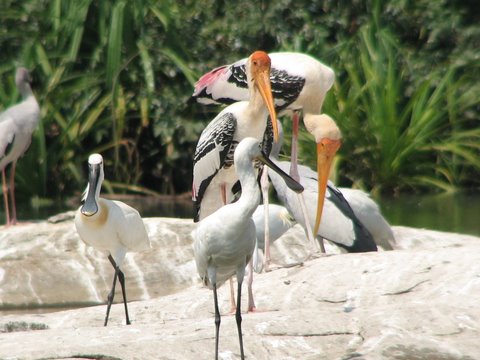
It is really reassuring to see such a Naturally evolved place still maintained in its Pristine condition. Any Nature Lover will enjoy the visit and would always love to
come back often. A List of nesting birds is also displayed with all their details and with appeals to conserve them.
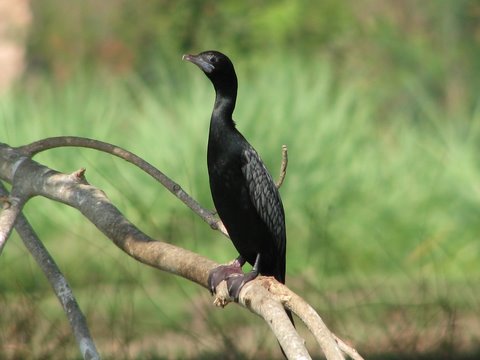
The Regular Birds: Open billed Storks, Painted storks, Spoonbills, White Ibis, Pond Heron, Little Heron, Plumed Heron, Night Heron, Darters, Little Cormorant, River Terns,
Plovers, Red-wattled lapwing, Peacock, Black Ibis, Kingfishers and the River Otters which
are a source of amusement as they dive in and out of sight of the visitors.
(Text and Photographs-RagooRao)
|
Posted by
Mohamed Sheik Ravuthar
on
February 07, 2007

|
POINT CALIMERE
M MOHAMED SHEIK RAVUTHAR
Forests and wildlife of Nagapattinam district
Other animals of the sanctuary include the jackal, spotted deer, jungle cat,
feral horses, black napped hare, etc. including a variety of reptiles.
From October to January nearly 90 species of migratory water birds
visit the sanctuary and its surroundings. They include Flamingoes, Painted storks,
Pelicans, Spoonbills, ducks, teals and a variety of shore birds. The best time to visit
the sanctuary for bird watching is November-December. The sanctuary is open to
visitors throughout the year.
A Forest Rest House at Kodiakkarai is available for visitors to the sanctuary.
Visitors may contact Wildlife Warden at 04365- 253092 or
Ranger, Kodiakkarai at 04369-272424

Blackbuck- the most important herbivore

Olive Ridley turtles nests in the sanctuary beach from Jan-March


On 14th November, 2000 a 35 ft long Bryde’s whale was rescued
from mud about 10 km west of Kodiakkarai. The rescue operation was
carried out with the active support of district administration. Pic: Top: A full grown Bryde’s whale. Bottom: Diagram showing padding of whale for towing during rescue.The sanctuary is now declared
as a Ramsar site
Sanctuary vegetation
Tropical dry-evergreen forest covers nearly 15 sq.kms of Pt. Calimere
Wildlife sanctuary. The forests are mostly of the nature of scrubland that
stands on low sand dunes located on the western half of the sanctuary.
Manilkara hexandra, locally called Palai is the most important evergreen
species of the sanctuary forest. In the sanctuary grasslands the dominant
graminoid is Aeluropus lagopoides followed by Sporobulu tremulus and
Cressa cretica. The forest is home to 154 species of medicinal plants
like Mucuna pruriens, Solanum trilobatum, Tinospora cordifolia Randia
dumatorum and Cissus quadrangularis
|
| |
|